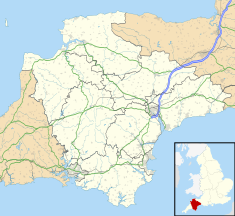
Barnstaple is a river-port town in North Devon, England, at the River Taw's lowest crossing point before the Bristol Channel. From the 14th century, it was licensed to export wool and won great wealth. Later it imported Irish wool, but its harbour silted up and other trades developed such as shipbuilding, foundries and sawmills. A Victorian market building survives, with a high glass and timber roof on iron columns. The parish population was 24,033 at the 2011 census, and that of the built-up area 32,411 in 2018. The town area with nearby settlements such as Bishop's Tawton, Fremington and Landkey, had a 2020 population of 46,619.

Lynton is a town on the Exmoor coast in the North Devon district in the county of Devon, England, approximately 17 miles (27 km) north-east of Barnstaple and 18 miles (29 km) west of Minehead, and close to the confluence of the West Lyn and East Lyn rivers.

North Devon is a local government district in Devon, England. North Devon Council is based in Barnstaple. Other towns and villages in the North Devon District include Braunton, Fremington, Ilfracombe, Instow, South Molton, Lynton and Lynmouth. The district was formed on 1 April 1974 as a merger of the Barnstaple municipal borough, the Ilfracombe and Lynton urban districts, and the Barnstaple and South Molton rural districts.
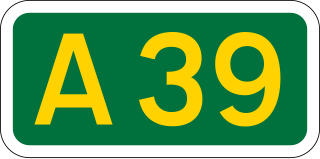
The A39 is an A road in south west England. It runs south-west from Bath in Somerset through Wells, Glastonbury, Street and Bridgwater. It then follows the north coast of Somerset, Devon and Cornwall through Williton, Minehead, Porlock, Lynmouth, Barnstaple, Bideford, Stratton, Camelford, Wadebridge and St Columb Major. It then joins the route of the A30 road for around 5 miles (8.0 km), re-emerging near Zelah to head for the south Cornish coast via Truro and Falmouth.

Lynmouth is a village in Devon, England, on the northern edge of Exmoor. The village straddles the confluence of the West Lyn and East Lyn rivers, in a gorge 700 feet (210 m) below Lynton, which was the only place to expand to once Lynmouth became as built-up as possible. The villages are connected by the Lynton and Lynmouth Cliff Railway, which works two cable-connected cars by gravity, using water tanks.
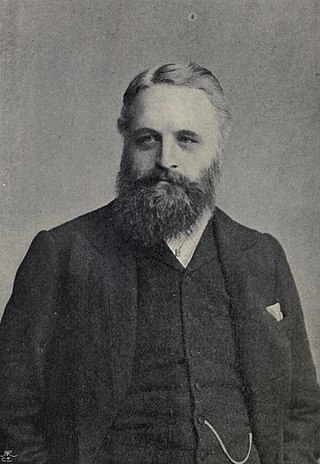
Sir George Newnes, 1st Baronet was a British publisher and editor and a founding figure in popular journalism. Newnes also served as a Liberal Party Member of Parliament for two decades. His company, George Newnes Ltd, was known for such periodicals as Tit-Bits and The Strand Magazine; it continued publishing ground-breaking consumer magazines such as Nova long after his death.

The Bridgnorth Cliff Railway, also known as the Bridgnorth Funicular Railway or Castle Hill Railway, is a funicular railway in the town of Bridgnorth in the English county of Shropshire. The line links the Low Town of Bridgnorth, adjacent to the River Severn, with the High Town, adjacent to the ruins of Bridgnorth Castle.
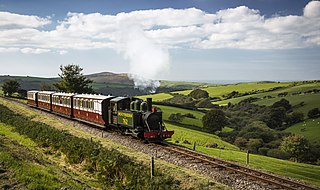
The Lynton and Barnstaple Railway (L&B) opened as an independent railway in May 1898. It was a single track, 1 ft 11+1⁄2 in narrow gauge railway and was slightly over 19 miles (31 km) long running through the rugged and picturesque area bordering Exmoor in North Devon, England. Although opened after the Light Railways Act 1896 came into force, it was authorised and constructed prior to that act. Therefore, as with all other railways, it was authorised under its own Act of Parliament and built to higher standards than similar railways of the time. In the United Kingdom it was notable as being the only narrow gauge line required to use main-line standard signalling. For a short period the line earned a modest return for shareholders, but for most of its life the L&B made a loss. In 1923, the L&B was taken over by the Southern Railway, and eventually closed in September 1935.

Woody Bay is a bay on the North Devon coast of England, 3 miles (4.8 km) west of Lynton and 8 miles (13 km) east of Combe Martin with a stony beach. It lies in the civil parish of Martinhoe at the edge of the Exmoor National Park and is a waypoint on the South West Coast Path. There were once plans to develop the area to become a holiday resort.

Chelfham railway station was a station on the Lynton and Barnstaple Railway, a narrow gauge line that ran through Exmoor from Barnstaple to Lynton and Lynmouth in North Devon, England. The station stood at the head of the spectacular Chelfham Viaduct, and served the village of Chelfham below.

Lynton and Lynmouth railway station was the terminus of the Lynton and Barnstaple Railway, a narrow gauge line that ran through Exmoor from Barnstaple to Lynton and Lynmouth in North Devon, England. The station served the twin towns of Lynton and Lynmouth.
Parracombe railway station was a halt on the Lynton & Barnstaple Railway, a narrow gauge line that ran through Exmoor from Barnstaple to Lynton and Lynmouth in North Devon, England. The Halt which served the village of Parracombe comprised a simple wooden shelter and was not opened until 1 May 1899 — almost a year after the line was opened on 16 May 1898 — and closed along with the rest of the railway on 29 September 1935. It is planned this station will be reopened next by the Lynton & Barnstaple Trust. It will replace the station at Killington Lane a bit further to the north that was opened in 2006.
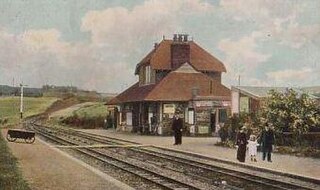
Woody Bay, within the Exmoor National Park, is a station on the former Lynton and Barnstaple Railway, a narrow gauge line that ran through Exmoor from Barnstaple to Lynton and Lynmouth in North Devon. The station was situated inland, about 1 1/2 miles from Woody Bay itself.
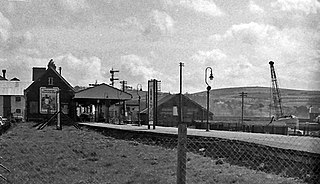
Barnstaple Town railway station was an intermediate station on the L&SWR line to Ilfracombe, England.

The Lynton and Lynmouth Cliff Railway is a water-powered funicular railway joining the twin towns of Lynton and Lynmouth on the rugged coast of North Devon in southwest England.
Pilton Yard, in Barnstaple was, between 1898 and 1935, the main depot and operating centre of the Lynton and Barnstaple Railway ('L&B'), a narrow gauge line that ran through Exmoor from Barnstaple to Lynton and Lynmouth in north Devon, England. Pilton station was served by regular passenger services advertised between 1898 and 1904 after which only goods facilities were provided. Passengers were catered for at the nearby LSWR station, Barnstaple Town, which provided connections with trains on the standard gauge branch line to Ilfracombe. The L&B's main offices were also based at Pilton, in a building formerly belonging to the Tannery which had earlier occupied the site, and which took over the site after the railway closed.

Lynton Village railway station is a station in Lynton, Devon, England served by the Lynton and Lynmouth Cliff Railway, a water-powered funicular railway.
Lynmouth Bay railway station is a station in Lynmouth, Devon, England, served by the Lynton and Lynmouth Cliff Railway, a water-powered funicular railway. The station has two platforms, a ticket booth, not an office, a bench and plenty of room. It opened in 1890.

Lynton and Lynmouth, also known as Little Switzerland, is the scenic landscape in and around the villages of Lynton and Lynmouth in Devon, which resembles the landscapes of Switzerland. It includes the surrounding coast and countryside: Valley of Rocks, Watersmeet and Heddon Valley. The resemblance was popularised by the Romantic Movement poets Wordsworth, Coleridge, Shelley and Southey:
From the Summerhouse Hill between the two is a prospect most magnificent - on either hand, combes and river; before, the beautiful little village, which, I am assured by one who is familiar with Switzerland, resembles a Swiss village".

Martinhoe is a small settlement and civil parish in North Devon district of Devon, England. Martinhoe is within the Exmoor National Park, the smallest National Park in England. In the 2011 census Martinhoe Parish was recorded as having a population of 159. Martinhoe is in the Combe Martin ward, for elections to the district council. Martinhoe's local government takes the form of a parish meeting and as such has no parish council nor elected parish councillors.

